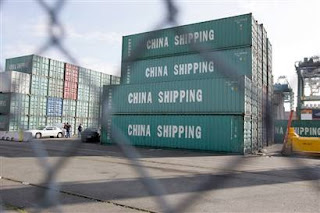Dry Bulk Shipping Recovery?
 MIRAL SHIPPING DRY BULK FREIGHT REPORT
MIRAL SHIPPING DRY BULK FREIGHT REPORTOctober 10, 2011
After a difficult summer, is dry bulk shipping on the road to recovery?
 Mr. Alexander J. Miral, founder of Miral Shipping Company, is an independent shipbroker and consultant to commodity traders. Mr. Miral has been contributing to our expert blog, Wall Street Greek, as a Senior Analyst and Shipping Columnist since 2009.
Mr. Alexander J. Miral, founder of Miral Shipping Company, is an independent shipbroker and consultant to commodity traders. Mr. Miral has been contributing to our expert blog, Wall Street Greek, as a Senior Analyst and Shipping Columnist since 2009.Relative Tickers: NYSE: TK, NYSE: NM, NYSE: NNA, NYSE: NMM, NYSE: TNP, NYSE: OSG, NYSE: ISH, NYSE: EXM, NYSE: SB, NYSE: SEA, NYSE: GNK, NYSE: DSX, NYSE: DAC, NYSE: TNP, NYSE: SFL, NYSE: NAT, NYSE: SSW, NYSE: GMR, NYSE: DHT, NYSE: BC, NYSE: MPX, Nasdaq: DRYS, Nasdaq: TOPS, Nasdaq: EGLE, Nasdaq: SINO, Nasdaq: PRGN, NYSE: KSP, Nasdaq: ESEA, Nasdaq: SBLK, Nasdaq: ONAV, Nasdaq: VLCCF, Nasdaq: TBSI, Nasdaq: GLNG, Nasdaq: XSEAX, Nasdaq: ACLI, NYSE: FDX, NYSE: UPS, Nasdaq: CHRW, Nasdaq: EXPD, Nasdaq: UTIW, Nasdaq: HUBG, NYSE: UNP, NYSE: CNI, NYSE: NSC, NYSE: CSX, NYSE: CP, NYSE: KSU, Nasdaq: JBHT, Nasdaq: LSTR, NYSE: CNW, NYSE: KNX, Nasdaq: WERN, Nasdaq: USAK, NYSE: NBG, NYSE: OTE and NYSE: CCH.
Dry Bulk Shipping Recovery?
2011 has been a difficult year for many in the shipping industry. The dry bulk market has fared better than most sectors of shipping but much of the year has seen low rates, capesize tonnage being hit particularly hard. However, to the surprise of most of us, the dry bulk market has experienced a substantial recovery beginning in the second half of August and rates continue to climb.
As of October 10, 2011 the BDI is at 2032, having crossed the key psychological barrier of 2000 this past Friday. Gains have occurred in all vessel classes, but capsizes have led the way increasing to $28,483 timecharter average per day, a three fold increase from where rates were early this summer. Panamaxes and supramaxes were at $15,561 and $16,150 timecharter average, respectively, representing approximately a $4,000 per day increase since early this summer. Handys have lagged but have still recovered to close to $11,000 tc average daily. It is surprising that these gains have come in the face of the debt crisis in Europe, and a slow economy in the United States.
The key to the freight recovery has been in the iron ore and coal trades, usually the two biggest drivers of dry bulk freight. Thermal coal demand has increased in advance of the northern hemisphere winter. Japan has increased its thermal coal imports as more coal plants have begun operating after the country’s loss in the tsunami disaster. China also imported a record amount of coal in August, some 10.1 million metric tons, representing an over 40% year-on-year increase. Part of this increase has been due to severe flooding in China, curtailing domestic production and necessitating replacement by imports. The global iron ore trade has also remained strong, with Chinese imports having increased over 10% since last year.
As I reported in previous columns, the export restrictions in India have meant increased shipments from more distant sources, meaning increased ton miles and an environment supportive of higher freight rates. Furthermore, the seasonal increase in grain shipments from the USA is underway, also contributing to a stronger Atlantic market. These trades have benefited all vessel classes, including handys since Indonesian coal volume that uses such vessels is way up.
Does this recovery have legs?
There are many reasons to think not. The global economy is at great risk, and if there is a global slowdown, freight will surely be impacted negatively. China has been the main steady driver of dry bulk freight, but even China is expected to slow down some, and eventually the iron ore trade could be impacted. The increase in thermal coal is seasonal to an extent and China’s great increase in coal imports should not last more than six months before falling back to more normal levels. The dry bulk order book is still high through the end of 2012, which is highly negative for freight rates. In fact, it has been reported that ship ordering activity is now quite low, indicating that owners are not confident of the freight rates holding up. One of the few sustained positives I could find is in the reconstruction in Japan, and later possibly Libya. However, taking into account the overall picture, I would not count on dry bulk freight to remain high past the short term.
Editor's Note: This article should interest investors in Teekay Corp. (NYSE: TK), Navios Maritime Holdings (NYSE: NM), Navios Maritime Acquisition (NYSE: NNA), Navios Maritime Partners L.P. (NYSE: NMM), Tsakos Energy Navigation Ltd. (NYSE: TNP), Overseas Shipholding Group (NYSE: OSG), International Shipholding (NYSE: ISH), Excel Maritime Carriers (NYSE: EXM), Safe Bulkers (NYSE: SB), Claymore/Delta Global Shipping ETF (NYSE: SEA), Genco Shipping & Trading (NYSE: GNK), Diana Shipping (NYSE: DSX), Danaos (NYSE: DAC), Tsakos Energy Navigation (NYSE: TNP), Ship Finance Int'l (NYSE: SFL), Nordic American Tanker (NYSE: NAT), Seaspan (NYSE: SSW), General Maritime (NYSE: GMR), DHT Maritime (NYSE: DHT), Brunswick (NYSE: BC), Marine Products Corp. (NYSE: MPX), DryShips (Nasdaq: DRYS), Top Ships (Nasdaq: TOPS), Eagle Bulk Shipping (Nasdaq: EGLE), Sino-Global Shipping (Nasdaq: SINO), Paragon Shipping (Nasdaq: PRGN), K-SEA Transportation Partners (NYSE: KSP), Euroseas (Nasdaq: ESEA), Star Bulk Carriers (Nasdaq: SBLK), Omega Navigation (Nasdaq: ONAV), Knightsbridge Tankers Ltd. (Nasdaq: VLCCF), TBS Int'l (Nasdaq: TBSI), Golar LNG (Nasdaq: GLNG), Claymore/Delta Global Shipping (Nasdaq: XSEAX), American Commercial Lines (Nasdaq: ACLI), National Bank of Greece (NYSE: NBG), Hellenic Telecommunications (NYSE: OTE), Coca-Cola HBC (NYSE: CCH).
Please see our disclosures at the Wall Street Greek website and author bio pages found there. This article and website in no way offers or represents financial or investment advice. Information is provided for entertainment purposes only.

Labels: Editors_Picks, Miral, Shipping, Shipping Market







































